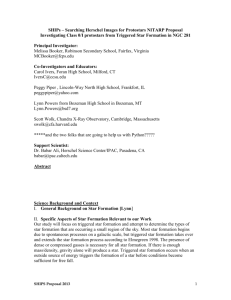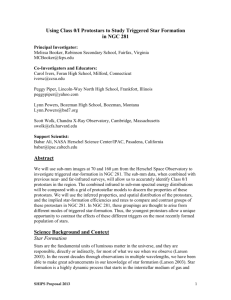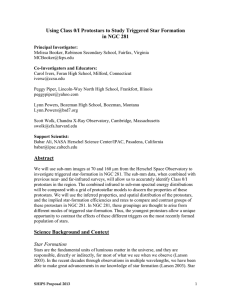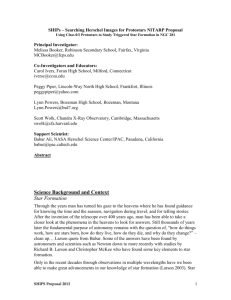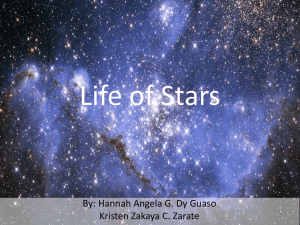Carol`s_Proposal_Section
advertisement
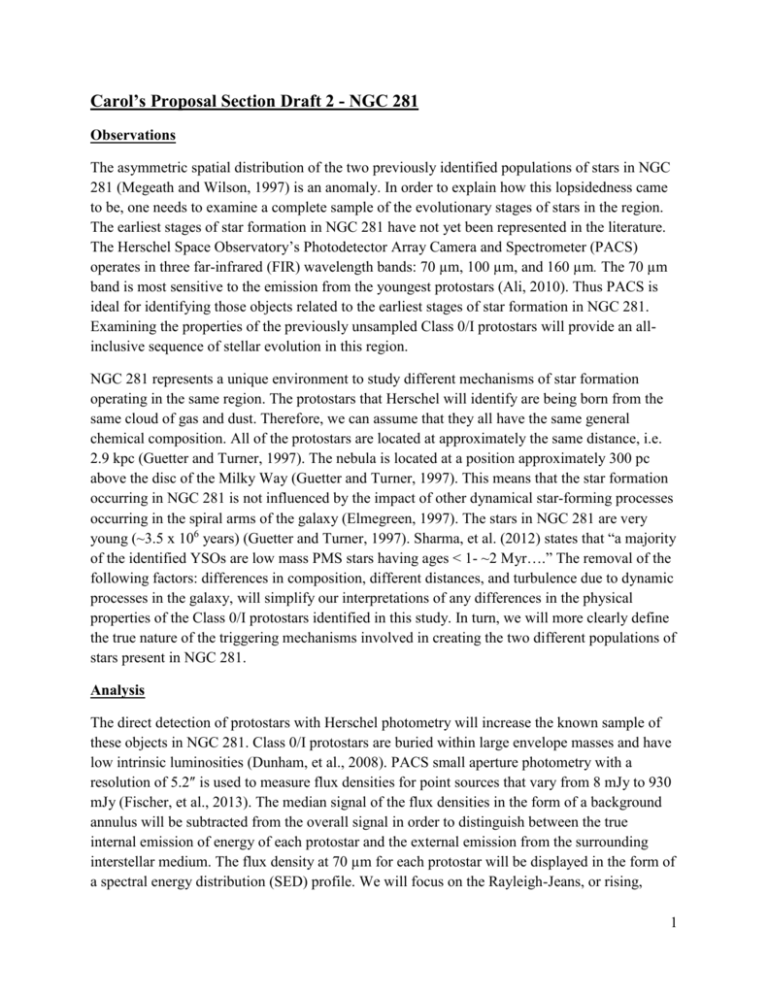
Carol’s Proposal Section Draft 2 - NGC 281 Observations The asymmetric spatial distribution of the two previously identified populations of stars in NGC 281 (Megeath and Wilson, 1997) is an anomaly. In order to explain how this lopsidedness came to be, one needs to examine a complete sample of the evolutionary stages of stars in the region. The earliest stages of star formation in NGC 281 have not yet been represented in the literature. The Herschel Space Observatory’s Photodetector Array Camera and Spectrometer (PACS) operates in three far-infrared (FIR) wavelength bands: 70 µm, 100 µm, and 160 µm. The 70 µm band is most sensitive to the emission from the youngest protostars (Ali, 2010). Thus PACS is ideal for identifying those objects related to the earliest stages of star formation in NGC 281. Examining the properties of the previously unsampled Class 0/I protostars will provide an allinclusive sequence of stellar evolution in this region. NGC 281 represents a unique environment to study different mechanisms of star formation operating in the same region. The protostars that Herschel will identify are being born from the same cloud of gas and dust. Therefore, we can assume that they all have the same general chemical composition. All of the protostars are located at approximately the same distance, i.e. 2.9 kpc (Guetter and Turner, 1997). The nebula is located at a position approximately 300 pc above the disc of the Milky Way (Guetter and Turner, 1997). This means that the star formation occurring in NGC 281 is not influenced by the impact of other dynamical star-forming processes occurring in the spiral arms of the galaxy (Elmegreen, 1997). The stars in NGC 281 are very young (~3.5 x 106 years) (Guetter and Turner, 1997). Sharma, et al. (2012) states that “a majority of the identified YSOs are low mass PMS stars having ages < 1- ~2 Myr….” The removal of the following factors: differences in composition, different distances, and turbulence due to dynamic processes in the galaxy, will simplify our interpretations of any differences in the physical properties of the Class 0/I protostars identified in this study. In turn, we will more clearly define the true nature of the triggering mechanisms involved in creating the two different populations of stars present in NGC 281. Analysis The direct detection of protostars with Herschel photometry will increase the known sample of these objects in NGC 281. Class 0/I protostars are buried within large envelope masses and have low intrinsic luminosities (Dunham, et al., 2008). PACS small aperture photometry with a resolution of 5.2″ is used to measure flux densities for point sources that vary from 8 mJy to 930 mJy (Fischer, et al., 2013). The median signal of the flux densities in the form of a background annulus will be subtracted from the overall signal in order to distinguish between the true internal emission of energy of each protostar and the external emission from the surrounding interstellar medium. The flux density at 70 µm for each protostar will be displayed in the form of a spectral energy distribution (SED) profile. We will focus on the Rayleigh-Jeans, or rising, 1 portion of each SED as this is where the emission from Class 0 protostars peaks while Class I protostars display SEDs that flatten after the peak (Rebull, 2012). SED profiles and the derived internal luminosities will be used to constrain the envelope mass, and thus the classification, of each protostar. A previously defined grid of radiative transfer models, generated with the Monte Carlo code of Whitney, et al. (2003), was constructed by Fischer, et al. (2013). This grid is built on the physical characteristics of protostars, i.e. envelope densities, cavity opening angles, overall inclinations, and internal luminosities. This same approach will be used in this study to constrain the physical properties and varied geometry of the newly identified Class 0/I objects in our sample. (See figure below.) Similarities and differences in SED models of embedded Class 0/I protostars in NGC 281 will allow us to discern any physical differences between the two populations of protostars that exist in the region. Figure ?. Model SED with peak at 70 µm and protostar geometry Ali, B., 2013, http://coolwiki.ipac.caltech.edu/index.php/StarFormation Dunham, et al. (2008) state that the value for the internal luminosity of an embedded protostar is not “a directly observable quantity” but that it is “tightly correlated with the 70 µm flux”. Bolometric luminosity (Lbol) “is calculated by integrating over the full SED” (Dunham, et al. (2008). Bolometric temperature (Tbol) is defined as “the temperature of a blackbody with the same flux-weighted mean frequency as the source (Meyers and Ladd, 1993). Similar to the approach of Evans, et al. (2008), we will use bolometric luminosity-temperature (BLT) diagrams to constrain the evolutionary stages of the embedded Class 0/I protostars in NGC 281. (See figure below.) 2 Figure ?. Locations of embedded protostars along with plots of evolutionary models of star formation (from Young & Evans, 2005) Dunham, et al. (2008) state that the data for embedded protostars in previous studies does not agree well with evolutionary models based on mass accretion rates. BLT diagrams for protostars in NGC 281 will add further evidence to test the validity of these models. Education/Public Outreach Team Foran High School (C. Ivers): Both high school and college students from different towns in CT will participate in the NITARP-based SHIPS research project as an extra-curricular independent study. The students involved will be required to investigate all concepts and diagnostic tools used to gain an understanding of the formation, birth, and evolution of stars. These topics will be discussed at weekly meetings and will mirror the learning taking place for teachers during weekly teleconferences. Students will be required to teach a portion of what they have already learned to others at each session. Data processing and analysis is a major portion of the student contribution to the project, so all students involved will learn to use the programming language Python. Educational outreach will involve teacher and student presentations within the local school district for other educators and students as well as for other area astronomy groups and colleges. 3 References Ali, B., Tobin, J. J., Fischer, W. J., et al., 2010, A&A 518, L119 Ali, B., 2013 http://coolwiki.ipac.caltech.edu/index.php/StarFormation Dunham, M.M., Crapsi, A., Evans, N.J., et al. 2008, ApJS, 179, 1 Elmegreen, B.G. 1998, ASP Conf. Ser., 148 Evans, N.J., et al. 2009, ApJS, 181, 2 Fischer, W.J., Megeath, S.T., Stutz, A.M., et al. 2013, AN, 334, 1-2 Guetter, H.H., & Turner, D.G. 1997, AJ, 113, 6 Megeath, S.T. & Wilson, T. L. 1997, AJ, 114, 3 Meyers, P. C., & Ladd, E.F., 1993, ApJ 413, L47 Rebull, L., 2012, http://coolwiki.ipac.caltech.edu/index.php/Studying_Young_Stars Sharma, S., Pandey, A.K., Pandey, J.C., et al. 2012, PASJ, 64, 5 Whitney, et al. 2003, ApJ, 591, 1049 Young, C. H. & Evans, N. J. 2005, ApJ, 627, 293 4


